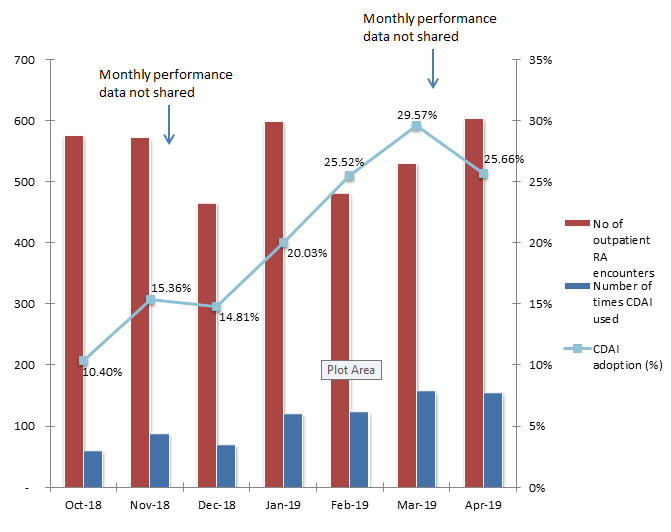Session Information
Session Type: Poster Session (Monday)
Session Time: 9:00AM-11:00AM
Background/Purpose: The 2015 American College of Rheumatology (ACR) guidelines for the treatment of rheumatoid arthritis (RA) strongly recommend using a treat-to-target (T2T) strategy that has demonstrated improved outcomes compared to a non-targeted approach. The crux of any T2T treatment pathway is accurate and consistent disease activity measurement using an ACR endorsed tool like the clinical disease activity index (CDAI). The aim of our study was to measure trends and predictors of CDAI adoption at our tertiary academic rheumatology practice comprised of community-based and teaching sites.
Methods: Consecutive adult RA patients at our tertiary care rheumatology practice beginning 10/1/18 were prospectively identified using a previously validated codified algorithm. As part of the T2T approach implementation, CDAI questionnaire completion rates by 21 providers were measured longitudinally. The formula utilized for CDAI calculation was ‘number of times CDAI score was completed’ divided by ‘total number of RA outpatient opportunities to complete CDAI’. Performance data was tracked longitudinally over 7 months and shared transparently at monthly intervals as aggregate and individual performance reports with all providers. We also segregated performance data by teaching faculty, trainees, non-physician providers, and disease activity level to help predict performance.
Results: A total of 3838 RA office visits with 21 providers were utilized for calculating aggregate CDAI performance metrics from 10/1/18 through 4/30/19 (Figure 1). Aggregate performance steadily improved from 10% to 26% over the 7 month period. Fellow trainees (NDV, AA) were found to have 90-100% CDAI utilization. Performance was noted to be skewed to a mean of 70% CDAI use by 6 teaching faculty compared to lower or no CDAI use at community-based sites. Sharing performance reports monthly by provider and aggregate via email was correlated with performance improvement in the month following the report, whereas a decline was noted in months of 12/18 and 4/19 where the previous month’s reports were not shared.
Conclusion: Longitudinally tracking performance metrics and sharing data transparently could be vital to implementing a disease activity measurement. Providers at teaching sites and trainees may be early adopters and are more likely to demonstrate steady performance improvement. We believe that this deeper understanding of variation would be helpful in building the foundation of future T2T based treatment pathways.
To cite this abstract in AMA style:
Sharma T, Wetherington K, Mcaninch L, Al Harash A, Vinod N, Manocha S, Dore A, Lucke M, Ayoub W, Wasko M. Factors Associated with Clinical Disease Activity Index Adoption at an Academic Rheumatology Practice [abstract]. Arthritis Rheumatol. 2019; 71 (suppl 10). https://acrabstracts.org/abstract/factors-associated-with-clinical-disease-activity-index-adoption-at-an-academic-rheumatology-practice/. Accessed .« Back to 2019 ACR/ARP Annual Meeting
ACR Meeting Abstracts - https://acrabstracts.org/abstract/factors-associated-with-clinical-disease-activity-index-adoption-at-an-academic-rheumatology-practice/

